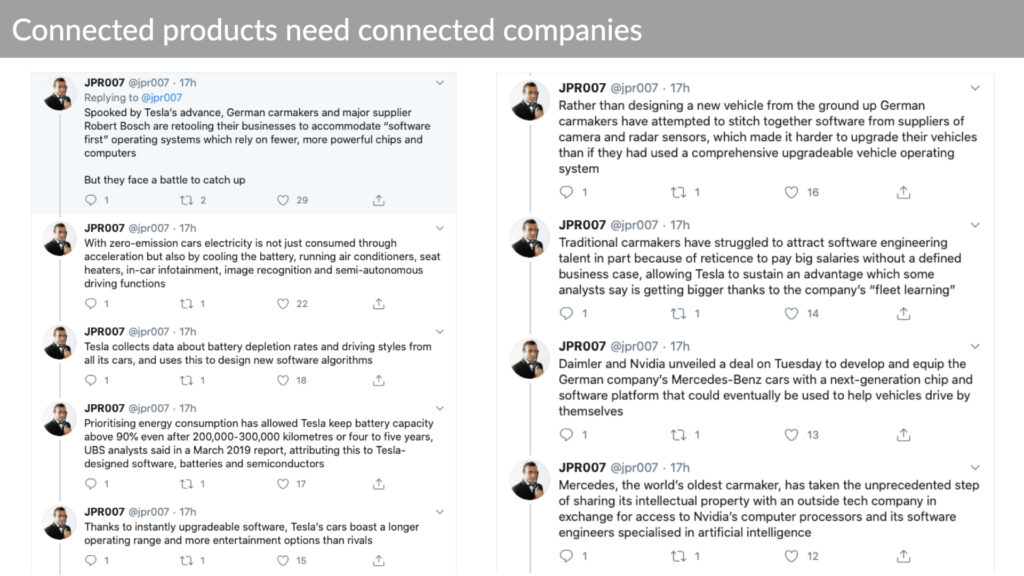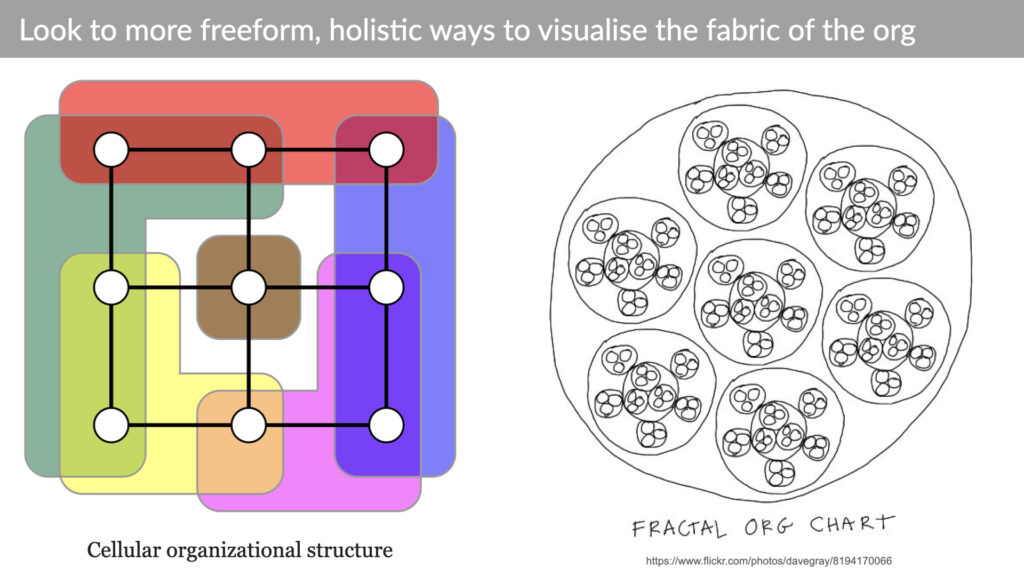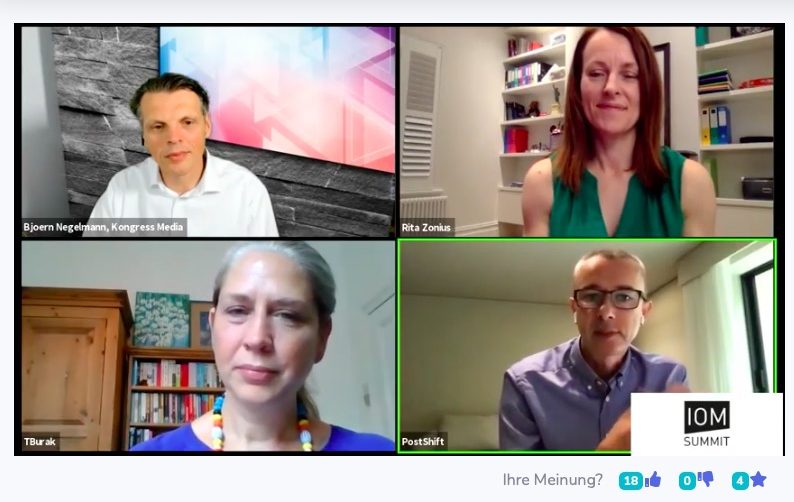What and where is your Organisational Fabric?
What and where is the fabric of your organisation? How would you describe it? When the buildings are empty and the conference rooms are silent, what actually *is* the organisation? Some might argue it is the sum of conversations, or processes, value chains or organisational structures. But where is it and how is it manifested?
In the digital era, the digital workplace should be that fabric. But it isn’t. At least, not yet. It has largely been co-opted and wrapped around the existing organisational structure and hierarchies – team spaces here, open “comms” space there and executive discussion spaces we know not where. The digital workplace has been a useful place of communication – mostly talking about work rather than doing work – and collaboration, but it is not yet a place of distributed, self-managed work and value creation.
But if its development has been slow and incremental thus far, could the current crisis lead to a sudden change in how work gets done?
We have been around long enough to see the various shifts in the digital workplace from the early social era, through Enterprise 2.0, collaboration apps and the present day. I confess I expected more progress than we have achieved. And I certainly didn’t expect to be *still* cursing Sharepoint whilst wearing sweatpants and working from the kitchen, along with everybody else, in 2020. Every organisation we worked with since the turn of the century had a 2020 vision or strategy, and they would all have been laughably wrong even if COVID-19 had not appeared.
We have perfectly viable alternatives to C20th bureaucratic management hierarchy. Agile management is already being taught and studied as the new normal for future managers. Distributed systems exist. Data, AI and ML are now seen as inevitable tools for running a business. But the cohort of managers who maintained and benefited from the old system have continued to hold all the reins of decision-making even after they faced their iPhone moment, or in Germany’s case their Tesla moment, over a decade ago.
This old system was designed around financialisation (hence the huge debt many large firms carry into today’s crisis), efficiency, vertical division and specialisation, compliance and top-down coordination. This reminds me of what evolutionary theorists call ‘intelligent design’. But what we need now is systems that are evolutionary, distributed, self-guiding, connected, agile and adaptive.
The two are so different that is is hard to argue you can iterate gradually from one to the other. In fact, a better way to think about this change is to grow a new structure from within the old, and then shed the unnecessary costs, bureaucracy and management structures that are no longer needed to coordinate value creation.
Take Tesla as as example. It survived cash crunches, PR crises, “production hell” and other obstacles to become the most valuable automotive firm in the world – not secretly, by stealth, but whilst in constant dialogue with the incumbent OEMs and major suppliers, who have known what Tesla were doing all the way along. Yet today, these reliable, powerful and well-funded firms remain a decade behind Tesla and are still coming to terms with what this means for their future. Just as Ford’s first mass market car was not a better horse, so the mass market vehicles Tesla are starting to produce are not just marginally better cars with electric drivetrains and some software bolted on top.
Some traditional car makers have finally realised that they need to get serious about their own integrated software systems inside the car, rather than just bolting together ‘parts’ from their supply chain. They have realised software is not just something you can buy in. It is a culture and a way of doing things, and in the context of electric or autonomous vehicles, it matters more than cabin lighting.

Patching holes versus weaving a new fabric
The same shift is needed within the organisations themselves. To really engage with software you need to be like software. You still need great leaders and exemplary managers, but you need to create an organisational operating system that is intelligent and data-driven to coordinate complex work. Connected products need connected companies.
The fabric of the organisation should be like the fabric of software. Processes as services, policies as algorithms, a resilient, fault-tolerated architecture, interfaces, data buses and pipelines, and libraries to connect thousands of independent components that are each optimised for their own fitness function or test. The doers on the factory floor, or in the offices, or out there in the field can achieve more at lower cost within this kind of system, than by waiting to be told what to do by a manager in meetings. Work happens until you tell it to stop, not the other way around.
Part of the challenge of shifting from meatspace management to an orgOS before COVID-19 was that the old system held everything together relatively well, and so new ways of working were wrapped around the old ones. The need for deeper change was missed. People like us who operate online, in networks and mostly remote, were the exception not the rule. But lockdown has changed the default quite literally overnight and companies of all kinds have had to adapt very quickly to remote working and online collaboration.
But remote working is just the most visible and immediate of the changes we are facing. Wholesale change could also be coming to the economy, money, urbanism, the link between employment and income. Entire sectors such as commercial property, airlines, hospitality and others are in the process of being up-ended and redefined. We are only just starting to see the contours of these disruptions and I suspect more surprises are to come. But if we zoom in on digital technology and consider the role it might play, it is worth bearing in mind several macro-level factors:
Technology is increasing utility whilst rapidly reducing the costs of doing so. Just this week, the UK’s stats body the ONS announced it would revise its account of Telecoms and internet price changes in the decade from 1997 to reflect a 95% reduction over that time, rather than the 50% their models had assumed. Our magic machines are doing things that only large firms could afford at one time.
Technology enables us to coordinate and automate in ways that we could not have imagined when we designed our current institutions and this will remove or re-design a vast number of existing roles in organisations, including expensive management jobs. This may even break the link between employment and income, leading to more applications of Universal Basic Income (UBI) in society.
Technology creates the opportunity for anyone to create value at scale, so the need for a specially-educated management class to operate the expensive and complicated machinery of the organisation and tell people what to do is reduced. This may even see the beginning of a meritocratic approach to remuneration in firms, where people with real skills and expertise are rewarded over sharp-elbowed generalists. See also “key workers” during a pandemic.
Grafting smart technology onto existing structures and processes can produce real improvement, as intermediate technologies such as Robot Process Automation (RPA) have demonstrated. But the real opportunity here is to create new, natively-digital work structures and cultures that can operate existing and future business models at a cost that is orders of magnitude lower, and yet also much faster and more effectively.
What have we learned so far during the sudden shift to remote?
Well first, let’s acknowledge that even before this crisis, there was a lot of evidence that remote working could be very successful in scaling a knowledge-based organisation. Firms like Automattic, GitHub or Basecamp were able to hire better, more diverse teams with a strong focus on work/life balance as more people became digital nomads or chose not to move to SF, NYC or London and live as commuters. We should listen to them and learn from their experience.
But since the lockdown, we have also learned that a lot of managers and management techniques simply do not work in Zoom and Teams. Without the office and its performative management theatre, work needs to get done online. Some managers and team leads are struggling to stay relevant or even getting in the way of the work their teams are doing. Instead of demanding your team’s attention and constantly interrupting them, maybe pick up some tasks and help out. Do the work and lead from inside the team. Similarly, internal functions that were tied into the management hierarchy, such as HR or internal comms, have sometimes struggled for relevance just when you might imagine they are most needed.

Related to this, we have also learned that video calls are not enough, and even if they were, they can be exhausting and strangely unsatisfying on a social level, like a cat watching birds on an iPad. People who spend their lives in meetings and calls have entered the new era doing exactly the same, but from home, with no pants, using Zoom or Teams or a.n.other tool rather than meeting face-to-face in a room. The idea that meetings are ‘work’ and constitute an act of value creation, rather than performative organisational politics, seems to persist even when there is no office. This needs to change.
We need to do more remote, asynchronous collaboration, and find better ways to normalise and coordinate synchronous collaboration in small teams. This means learning new norms, etiquette and also losing the idea of one-size-fits-all work patterns, as some people are productive in bursts, or late at night, or perhaps only when their kids are not yet out of bed. It turns out those ESNs and social platforms could be useful after all. We need a much richer and more diverse toolset in the digital workplace to cater for different work styles.
If we don’t get better at this very quickly, online meeting overload risks becoming workforce burnout.
People who are used to remote work, as opposed to just remote meetings, tend to operate a toolkit that is balanced between real-time synchronous (Slack, Teams, IRC), semi-synchronous (online collaboration tools – wikis, forums, collaborative planners and design tools, etc) and asynchronous deep work (anything from paper to coding tools). Almost all of these involve an element of sharing, collaboration or co-operation, but very few involve just talking to people. Remote meetings, on the other hand, are useful for catch-ups, checking in on people from time to time and sometimes even structured workshops or design sessions. For coding, Github-type tools are uber-collaborative, but the typical user is wearing headphones and is very much in do-not-disturb work mode.
In other words, don’t just talk, do some work! Write. Curate. Connect. Architect. Build on other peoples’ ideas. Share. Ask. Reflect. Show your working, accept feedback gracefully and start to learn the power of real collaboration and distributed work.
Yesteryear’s bloggers and today’s tweeters and ‘gramers understand that the social surface area you expose in terms of posts, tweets, articles or even photo captions can help create ‘ambient intimacy’ and improve your ‘findability’. Building relationships based on your ideas or content is a much easier and more rewarding form of networking than grinding your way through tedious office drinks events and then jumping on the night bus full of warm Chardonnay and self-hate. But it also has two other advantages: first, it means you can engage with somebody’s ideas without being prejudiced by appearances or first impressions; and, secondly, the signal-to-noise ratio is arguably higher than at the drinks reception.
All in all, this is a chance to fundamentally re-think how we work, how we use digital tools and how we impact on each other’s time and attention. So, where might we begin to give our organisations a little nudge towards the future?
Where to start weaving
There is an urgent need to improve the digital workplace and employee experience. Get together with other stakeholders and make the case to recycle real estate spend into digital real estate. Build on your platform of choice to create an integrated but diverse digital workplace with better tools, augmentation from bots and agents, an integrated platform of services that can replace manual processes, and rich social environments for people to meet each other and share ideas. Perhaps apply service design thinking to improve the digital EX for all forms of work, but don’t just digitise the old HR, IT and internal functions – start from the ideal employee experience instead and build out what is needed to support it.
Share more. Narrate your work. Advertise what your team does and how it can help. Find new ways to achieve ambient intimacy online (and hopefully we can also add back in social meet-ups in 2021) to replace some of the connection we are missing with Zoom and Teams calls. This will also make it easier to build networks, and find people and teams, which is something the old system did quite well – hierarchy had the benefit of legibility through its org charts and Kremlinology. We need to make it easier for anyone to identify where they are, how they can contribute and who can help.
Map the emerging digital organisation and help to surface the informal networks and connections where work gets done. Not the whole organisation, just the bits with a pulse and where people know how to operate a mobile device. Perhaps create interfaces to connect them on a peer-to-peer basis rather than organise around reporting lines. Ask each team to say where they are, what capabilities they have, the service they deliver and the special skills or methods they possess. Ideally, the description of their service(s) should look like a very simple version of software service or API documentation, which can help the organisation solve integration problems, but also provide an overview of the potential for automation. Perhaps do this mapping semi-regularly in depth and then update with pulse surveys to signal how they are doing right now, or what has changed since the last update. We tend to use a chatbot to gather this information, but online surveys can also work.
This simple strategy can give the organisation a better picture of where things are, what key capabilities its teams possess and also how they connect and coordinate to create value. Typically, it will also uncover duplication and waste, or the fact that five different teams have hired single data scientists or other specialists without joining forces or at least creating a community of practice. But in times like these, where a team or a whole region might go offline or face difficult working conditions, it can really help to build greater resilience and less dependency on up-down chains of command that go through single choke points.

When you have a better picture of your organisation’s digital capabilities, gaps and potential, help each team and department re-think what they do in terms of services, not processes, and in terms of the data and network connections they need. Help them use digital technology to automate what they can, systematise and build the core components of a digital shared service platform, which I think is the chassis for an orgOS.
But overall, move from adoption of tools into the organisation to real transformation of the organisation to become truly digital, connected and evolutionary. We desperately need new institutions for the C21st and to re-create or reform the impactful firms that helped shape modernity in the C20th. This can only be done in a distributed and agile way, so don’t wait for permission, but rather start to exemplify a better way. Find and connect those who look to the future and route around the rent seekers, chair fillers and room meat that are too vested in the old system, even if they know it is not working for anyone but themselves.
Agile, distributed, sensing, self-organised structures can evolve given the chance. It is their intersection with the old control systems that causes the biggest problems. That is a design challenge, but it is also a question of momentum. Water and waves. Be the change.
We, as digital practitioners, can help the emerging leaders grasp this once in a generation architectural opportunity and threat to create a new generation of digital firms with digital systems and leadership.
(this is an abridged version of a keynote talk given to the IOM Summit in July 2020)

